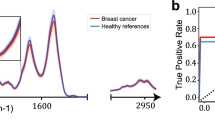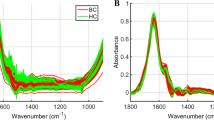Abstract
Background
Early detection of colorectal cancer (CRC) can reduce mortality and morbidity. Current screening methods include colonoscopy and stool tests, but a simple low-cost blood test would increase compliance. This preliminary study assessed the utility of analyzing the entire bio-molecular profile of peripheral blood mononuclear cells (PBMCs) and plasma using Fourier transform infrared (FTIR) spectroscopy for early detection of CRC.
Methods
Blood samples were prospectively collected from 62 candidates for CRC screening/diagnostic colonoscopy or surgery for colonic neoplasia. PBMCs and plasma were separated by Ficoll gradient, dried on zinc selenide slides, and placed under a FTIR microscope. FTIR spectra were analyzed for biomarkers and classified by principal component and discriminant analyses. Findings were compared among diagnostic groups.
Results
Significant changes in multiple bands that can serve as CRC biomarkers were observed in PBMCs (p = ~0.01) and plasma (p = ~0.0001) spectra. There were minor but statistically significant differences in both blood components between healthy individuals and patients with benign polyps. Following multivariate analysis, the healthy individuals could be well distinguished from patients with CRC, and the patients with benign polyps were mostly distributed as a distinct subgroup within the overlap region. Leave-one-out cross-validation for evaluating method performance yielded an area under the receiver operating characteristics curve of 0.77, with sensitivity 81.5 % and specificity 71.4 %.
Conclusions
Joint analysis of the biochemical profile of two blood components rather than a single biomarker is a promising strategy for early detection of CRC. Additional studies are required to validate our preliminary clinical results.




Similar content being viewed by others
Abbreviations
- AUC:
-
Area under the curve
- CA:
-
Cancer antigen
- CEA:
-
Carcinoembryonic antigen
- CRC:
-
Colorectal cancer
- FLDA:
-
Fisher linear discriminant analysis
- FTIR:
-
Fourier transform infrared
- PBMCs:
-
Peripheral blood mononuclear cells
- PCA:
-
Principal component analysis
- QDA:
-
Quadratic discriminant analysis
- ROC:
-
Receiver operating characteristics
References
Siegel R, Ma J, Zou Z, Jemal A. Cancer statistics, 2014. CA Cancer J Clin. 2014;64(1):9–29.
Shapiro JA, Klabunde CN, Thompson TD, et al. Patterns of colorectal cancer test use, including CT colonography, in the 2010 National Health Interview Survey. Cancer Epidemiol Biomark Prev. 2012;21(6):895–904.
Parra-Blanco A, Gimeno-García AZ, Quintero E, et al. Diagnostic accuracy of immunochemical versus guaiac faecal occult blood tests for colorectal cancer screening. J Gastroenterol. 2010;45(7):703–12.
Sturgeon CM, Duffy MJ, Stenman U-H, et al. National Academy of Clinical Biochemistry laboratory medicine practice guidelines for use of tumor markers in testicular, prostate, colorectal, breast, and ovarian cancers. Clin Chem. 2008;54(12):e11–79.
Church TR, Wandell M, Lofton-Day C, et al. Prospective evaluation of methylated SEPT9 in plasma for detection of asymptomatic colorectal cancer. Gut. 2014;63(2):317–25.
Nichita C, Ciarloni L, Monnier-Benoit S, et al. A novel gene expression signature in peripheral blood mononuclear cells for early detection of colorectal cancer. Aliment Pharmacol Ther. 2014;39(5):507–17.
Mantsch HH, Chapman D. Infrared spectroscopy of biomolecules. New York: Wiley; 1996.
Argov S, Sahu RK, Bernshtain E, et al. Inflamatory bowel diseases as an intermediate stage between normal and cancer: a FTIR-microspectroscopy approach. Biopolymers. 2004;75(5):384–92.
Sahu R, Mordechai S. Fourier transform infrared spectroscopy in cancer detection. Future oncol. 2005;1(5):635–47.
Ladoire S, Martin F, Ghiringhelli F. Prognostic role of FOXP3+ regulatory T cells infiltrating human carcinomas: the paradox of colorectal cancer. Cancer immunol immunother CII. 2011;60(7):909–18.
Handy B. The clinical utility of tumor markers. Lab Med. 2009;40(2):99–103.
Ostrovsky E, Zelig U, Gusakova I, et al. Detection of cancer using advanced computerized analysis of infrared spectra of peripheral blood. IEEE trans bio-med eng. 2013;60(2):343–53.
Zelig U, Mordechai S, Shubinsky G, et al. Pre-screening and follow-up of childhood acute leukemia using biochemical infrared analysis of peripheral blood mononuclear cells. Biochim Biophys Acta. 2011;1810(9):827–35.
Bird B, Miljkovic M, Romeo MJ, et al. Infrared micro-spectral imaging: distinction of tissue types in axillary lymph node histology. BMC clinical pathology. 2008;8(1):8.
Toyran N, Lasch P, Naumann D, et al. Early alterations in myocardia and vessels of the diabetic rat heart: an FTIR microspectroscopic study. Biochem J. 2006;397(3):427–36.
Duda RO, Hart PE, Stork DG. Pattern classification. 2nd ed. New York: Wiley; 2012.
Toll A, Fabius D, Hyslop T, et al. Prognostic significance of high-grade dysplasia in colorectal adenomas. Colorectal Dis. 2011;13(4):370–3.
Lasch P. Spectral pre-processing for biomedical vibrational spectroscopy and microspectroscopic imaging. Chemom Intell Lab Syst. 2012;117:100–14.
Movasaghi Z, Rehman S, Rehman IU. Fourier transform infrared (FTIR) spectroscopy of biological tissues. Appl Spectrosc Rev. 2008;43:134–79.
Liu KZ, Xu M, Scott DA. Biomolecular characterisation of leucocytes by infrared spectroscopy. Br J Haematol. 2007;136(5):713–22.
Beyer M, Schultze JL. Regulatory T cells in cancer. Blood. 2006;108(3):804–11.
Grivennikov SI, Greten FR, Karin M. Immunity, inflammation, and cancer. Cell. 2010;140(6):883–99.
Gounaris E, Blatner NR, Dennis K, et al. T-regulatory cells shift from a protective anti-inflammatory to a cancer-promoting proinflammatory phenotype in polyposis. Cancer Res. 2009;69(13):5490–7.
Tokuno K, Hazama S, Yoshino S, et al. Increased prevalence of regulatory T-cells in the peripheral blood of patients with gastrointestinal cancer. Anticancer Res. 2009;29(5):1527–32.
Sasada T, Kimura M, Yoshida Y, et al. CD4+CD25+ regulatory T cells in patients with gastrointestinal malignancies. Cancer. 2003;98(5):1089–99.
Salama P, Phillips M, Grieu F, et al. Tumor-infiltrating FOXP3+ T regulatory cells show strong prognostic significance in colorectal cancer. J Clin Oncol. 2009;27(2):186–92.
Pagès F, Berger A, Camus M, et al. Effector memory T cells, early metastasis, and survival in colorectal cancer. N Engl J Med. 2005;353(25):2654–66.
Hands JR, Dorling KM, Abel P, et al. Attenuated total reflection Fourier transform infrared (ATR-FTIR) spectral discrimination of brain tumour severity from serum samples. J Biophotonics. 2014;7(3–4):189–99.
Gajjar K, Trevisan J, Owens G, et al. Fourier-transform infrared spectroscopy coupled with a classification machine for the analysis of blood plasma or serum: a novel diagnostic approach for ovarian cancer. Analyst. 2013;138(14):3917–26.
Ollesch J, Heinze M, Heise HM, et al. It’s in your blood: spectral biomarker candidates for urinary bladder cancer from automated FTIR spectroscopy. J Biophotonics. 2014;7(3–4):210–21.
Mead R, Duku M, Bhandari P, Cree IA. Circulating tumour markers can define patients with normal colons, benign polyps, and cancers. Br J Cancer. 2011;105(2):239–45.
Wild N, Andres H, Rollinger W, et al. A combination of serum markers for the early detection of colorectal cancer. Clin Cancer Res. 2010;16(24):6111–21.
Seo JY, Chun J, Lee C, Hong KS, Im JP, Kim SG, Jung HC, Kim JS. Novel risk stratification for recurrence after endoscopic resection of advanced colorectal adenoma. Gastrointest Endosc. 2015;81(3):655–64.
Engwegen JY, Depla AC, Smits ME, et al. Detection of colorectal cancer by serum and tissue protein profiling: a prospective study in a population at risk. Biomarker Insights. 2008;3:375.
Yesil A, Babacan Abanonu G, Colak Y, et al. Prognostic significance of DR-70 levels in dysplastic colorectal polyps. Gastroenterol Res Pract. 2013;2013:1–7. Art. ID 275392. doi:10.1155/2013/275392.
Vatandoost N, Ghanbari J, Mojaver M, et al. Early detection of colorectal cancer: from conventional methods to novel biomarkers. J Cancer Res Clin Oncol. 2015. doi:10.1007/s00432-015-1928-z.
Acknowledgments
We thank Ela Ostrovsky who participated in spectral data analysis. This work was funded in part by Todos Medical Ltd. and the Chief Scientist Office, Israel.
Conflict of interest
Dr. Udi Zelig, Omri Bar and Cheli Segev are employees at Todos Medical Ltd. Prof. Joseph Kapelushnik, Prof. Shaul Mordechai and Prof. Ilana Nathan serves as consultants to Todos Medical Ltd.
Author information
Authors and Affiliations
Corresponding author
Additional information
E. Barlev and U. Zelig contributed equally to this work.
Rights and permissions
About this article
Cite this article
Barlev, E., Zelig, U., Bar, O. et al. A novel method for screening colorectal cancer by infrared spectroscopy of peripheral blood mononuclear cells and plasma. J Gastroenterol 51, 214–221 (2016). https://doi.org/10.1007/s00535-015-1095-7
Received:
Accepted:
Published:
Issue Date:
DOI: https://doi.org/10.1007/s00535-015-1095-7




